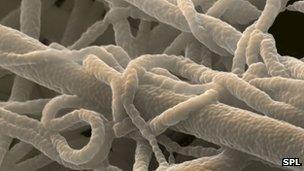Nanofibres 'may pose health risk'
-
Published

Inhaling tiny fibres made by the nanotechnology industry could cause similar health problems to asbestos, say researchers.
Some are similar in shape to asbestos fibres, which have caused lung cancers such as mesothelioma.
Research on mice, published in Toxicology Sciences, suggests the longer nanofibres are more dangerous.
Human and mouse lungs are different, but the researchers hope the study will help to design safer nanofibres.
Nanofibres are in a range of goods, from aeroplane wings to tennis rackets.
Ken Donaldson, professor of respiratory toxicology at the University of Edinburgh, said: "Concern has been expressed that new kinds of nanofibres being made by nanotechnology industries might pose a risk because they have a similar shape to asbestos."
Silver nanofibres of varying lengths were injected into the lungs of mice.
Those larger than five micrometres, or five-thousandths of a millimetre, tended to become lodged in the lungs and cause inflammation. The smaller ones were cleared from the lungs.
Safety
Prof Donaldson said: "We knew that long fibres, compared with shorter fibres, could cause tumours, but until now we did not know the cut-off length at which this happened.
"Knowing the length beyond which the tiny fibres can cause disease is important in ensuring that safe fibres are made in the future as well as helping to understand the current risk from asbestos and other fibres."
Prof Stephen Spiro, from the British Lung Foundation, said cases of mesothelioma had almost quadrupled in the past 30 years because of asbestos.
He added: "This research is particularly interesting as it gives us an indication of the size of fibre that might lead to mesothelioma if inhaled.
"If confirmed by subsequent studies, this minimum fibre length can be cited in industry guidelines to help ensure people are not exposed to the sorts of fibres that may lead to such deadly diseases."
-
-
Published22 June 2012
-